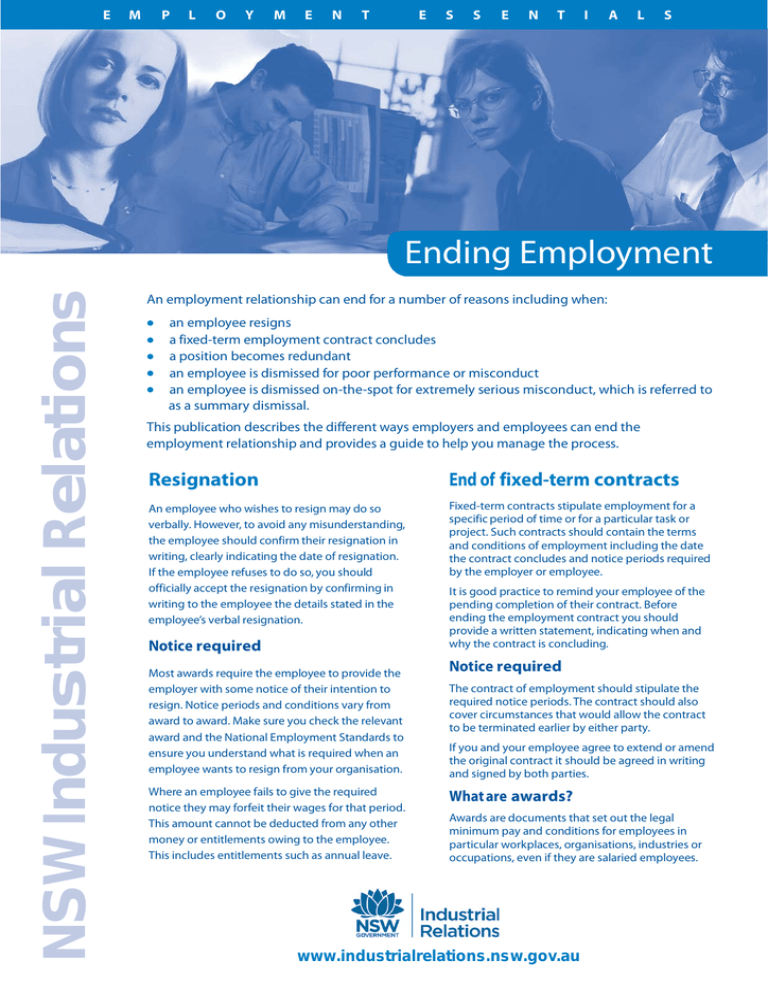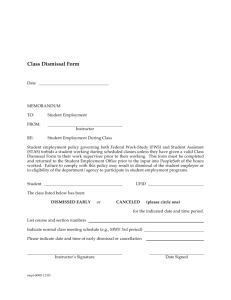Employment Essentials - Ending Employment
advertisement

E M P L O Y M E N T E S S E N T I A L S NSW Industrial Relations Ending Employment An employment relationship can end for a number of reasons including when: • • • • • an employee resigns a fixed-term employment contract concludes a position becomes redundant an employee is dismissed for poor performance or misconduct an employee is dismissed on-the-spot for extremely serious misconduct, which is referred to as a summary dismissal. This publication describes the different ways employers and employees can end the employment relationship and provides a guide to help you manage the process. Resignation End of fixed-term contracts An employee who wishes to resign may do so verbally. However, to avoid any misunderstanding, the employee should confirm their resignation in writing, clearly indicating the date of resignation. If the employee refuses to do so, you should officially accept the resignation by confirming in writing to the employee the details stated in the employee’s verbal resignation. Fixed-term contracts stipulate employment for a specific period of time or for a particular task or project. Such contracts should contain the terms and conditions of employment including the date the contract concludes and notice periods required by the employer or employee. Notice required Most awards require the employee to provide the employer with some notice of their intention to resign. Notice periods and conditions vary from award to award. Make sure you check the relevant award and the National Employment Standards to ensure you understand what is required when an employee wants to resign from your organisation. Where an employee fails to give the required notice they may forfeit their wages for that period. This amount cannot be deducted from any other money or entitlements owing to the employee. This includes entitlements such as annual leave. It is good practice to remind your employee of the pending completion of their contract. Before ending the employment contract you should provide a written statement, indicating when and why the contract is concluding. Notice required The contract of employment should stipulate the required notice periods. The contract should also cover circumstances that would allow the contract to be terminated earlier by either party. If you and your employee agree to extend or amend the original contract it should be agreed in writing and signed by both parties. What are awards? Awards are documents that set out the legal minimum pay and conditions for employees in particular workplaces, organisations, industries or occupations, even if they are salaried employees. www.industrialrelations.nsw.gov.au NSW Industrial Relations Redundancy pay period Notice Employers are required to give employees notice of termination. The National Employment Standards provide a scale of minimum notice periods based on the length of service. Notice schedule Employee’s period of continuous service with the employer on termination Redundancy pay period At least one year, but less than two years Four weeks At least two years, but less than three years Six weeks At least three years, but less than four years Seven weeks Employee’s period of continuous service with the employer at the end of the day the notice is given Period Not more than one year One week At least four years, but less than five years Eight weeks More than one year, but not more than three years Two weeks At least five years, but less than six years 10 weeks More than three years, but not more than five years Three weeks At least six years, but less than seven years 11 weeks More than five years Four weeks At least seven years, but less than eight years 13 weeks At least eight years, but less than nine years 14 weeks At least nine years, but less than 10 years 16 weeks At least 10 years 12 weeks Redundancy Before making an employee redundant, there are three requirements that must be met: 1. the job is no longer required to be done by anyone 2. consultation requirements specified under an award or enterprise agreement have been met 3. opportunities for redeployment within the business or associated entity have been considered. The redundancy can only proceed if redeployment cannot be reasonably accommodated. Redundancy payments The National Employment Standards, which outline the minimum entitlements for all national system employees, include an entitlement in relation to severance payments where the employer has 15 or more employees. If an award or agreement specifies higher severance payments than the National Employment Standards, the higher amount will apply. Some awards and agreements provide for severance payments even where the employer has less than 15 employees. These terms continue to apply. Dismissal You must have a valid reason for dismissing an employee. The reason must be based on: • • • poor performance, or misconduct, or extremely serious misconduct, resulting in onthe-spot termination (summary dismissal). Dismissal for poor performance and misconduct If the employee is being dismissed because of poor performance, their work history must justify your action. You must ensure the employee understands why you are not happy with their performance or Ending Employment behaviour. They should also be given the opportunity to respond and improve their performance. It is important that the final written warning to the employee indicates that they could lose their job if their performance or attitude does not improve. If a breach of company policy can lead to dismissal, it must be clear to employees. You also need to ensure that each employee reads and understands the policy. If an employee is being dismissed for misconduct, you should get legal advice or contact your employer organisation. Ensure that the employee understands the reasons for termination. It can save problems later if this has been made clear. Do I need to give three warnings for poor performance or misconduct? Unless specifically stated in an award or agreement you do not have to give three warnings (written or otherwise). However, you should give your employee opportunities to improve their performance without having to issue a large number of open-ended warnings. Small business employers can also refer to the Small Business Fair Dismissal Code. The Code identifies situations in which no warning or one warning is appropriate. For more information about the Code, please contact the Fair Work Infoline on 13 13 94 or go to www.fairwork.gov.au. Written notice of termination A written notice of termination is a letter confirming the termination of employment and the reasons for termination. In all of the above circumstances it is recommended you give written notice of the termination. You should also provide the employee with a certificate of service or an employment separation certificate, which can be obtained from Centrelink, indicating the period of employment, job classification and type of work undertaken. Constructive dismissal A constructive or forced dismissal occurs when conditions are unfairly applied to an employee which forces them to resign. This includes: • telling the employee to ‘resign or be dismissed’ • demoting an employee where the demotion involves a significant reduction in the employee’s remuneration or duties • unfairly changing an employee’s working arrangements such as start and finish times, days and other hours worked where these changes are unfair. Summary dismissal The employee may later prove that your actions effectively forced their resignation. Summary dismissal is instant or on-the-spot termination, usually reserved for extremely serious misconduct by an employee. Unfair dismissal When considering summary dismissal, ask yourself the following questions: • was the employee aware that their actions or behaviour would lead to instant dismissal? The Fair Work Act 2009 allows an employee to apply for unfair dismissal if they believe their employment has been unfairly terminated. • has the employee been given a chance to explain what happened? A dismissal is unfair when it is harsh, unjust or unreasonable. In dealing with a claim, Fair Work Australia may take into account whether: • did I act promptly when the incident occurred? • a valid reason for dismissal was given • would an impartial person, that is someone not involved, agree that the employee’s conduct was seriously improper? • the applicant was given an opportunity to respond • the employer unreasonably refused to allow the applicant to have had a support person present • the applicant was given any prior warnings • the size of the business or lack of HR expertise impacted on the processes followed by the employer. • have I followed proper policy and procedure and verified that the alleged misconduct actually took place and by this person? You should not proceed with a summary dismissal if you answered ‘no’ to any of these questions. In a summary dismissal you have the right to dismiss an employee without notice, or payment in lieu of notice. Unlawful dismissal • absence from work during maternity leave or other parental leave Unlawful dismissal occurs when an employee is dismissed for any of the following reasons: • reasonable temporary absence from work for • • • • • • the purpose of engaging in a voluntary emergency management activity, e.g. working temporary absence from work because of illness or injury as a registered volunteer for the State Emergency Service (SES) trade union membership or participation in trade union activities outside working hours or, with the employer’s consent, during working hours For further information please contact the Fair Work Infoline on 13 13 94. non-membership of a trade union General protections seeking office as, acting or having acted as a representative of employees Employees who believe their workplace rights filing a complaint or participating in proceedings against an employer involving alleged violation of laws, regulations or recourse to competent administrative authorities have been threatened by their employer, or who believe they have been treated unfairly by their employer, can ask Fair Work Australia to intervene. race, colour, sex, sexual preference, age, physical or mental disability, marital status, family or carer’s responsibilities, pregnancy, religion, political opinion, national extraction or social origin For more information about workplace rights and general protections, please contact the Fair Work Infoline on 13 13 94 or go to www.fairwork.gov.au. Other titles in the Employment Essentials series • Introducing Workplace Flexibility • Managing People • Managing Performance • Workplace Policies and Procedures To find out information about the NSW Industrial Relations' workshop and webinar program, contact NSW Industrial Relations Employer Education Services. NSW Industrial Relations www.industrialrelations.nsw.gov.au Email: NSW IR Workshops at irworkshops@industrialrelations.nsw.gov.au Telephone: (02) 9228 5986 or follow NSW_IR on Twitter Supporting fair and productive workplaces. Disclaimer: This publication is intended to be a general guide only. All due care has been taken in its preparation, and the information is believed to be current at the date of publication. For further information check the NSW IR website at www.industrialrelations.nsw.gov.au or call Education Services on 02 9228 5986 Last Updated: July 2013

